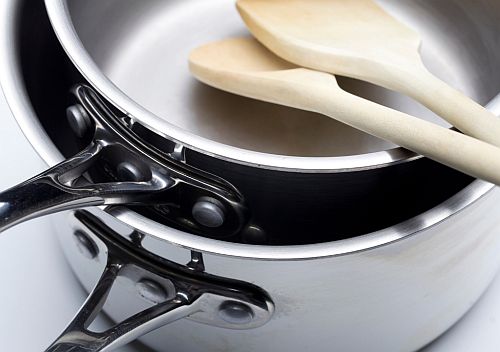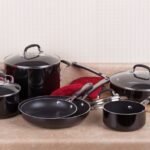Although All-Clad pans are not high-maintenance cookware, they must be properly cleaned after each use. Non-proper maintenance can cause the loss of their initial shiny appearance. Here are the most common reasons why your All-Clad cookware doesn’t look as good as it did before.
- Using cooking spray leaves films on the surface, causing discoloration and sticking.
- Overheating can result in blue stains and clouding on the bottom.
- Rinsing stainless steel cookware in water with high levels of iron can cause rusty discoloration.
- Rinsing cookware in water with high calcium content can leave water spots on the outside.
- Normal use can cause fingerprints and mild staining on the surface.
- All-clad cookware with a copper exterior can lose a mirror finish and develop a patina over time.
Fortunately, All-Clad cookware is easy to clean with commercially available cleaning products.

Is All-Clad Cookware Dishwasher-Safe?
1. The stainless line of All-Clad cookware is completely dishwasher-safe. This collection can be safely placed in the dishwasher (excluding non-stick cookware).
2. The Copper-Core All-Clad cookware collection can be placed in the dishwasher per instruction, but this may cause tarnishing of the copper ring around the exterior. To avoid this, choose hand washing or dry the exterior with a clean microfiber cloth immediately after the wash cycle has been completed.
3. All other collections should not go in the dishwasher. To make sure you clean your All-Clad cookware properly, read and follow the manufacturer’s instructions.
Dishwasher Washing
It is recommended you wash your stainless steel All-Clad cookware in the dishwasher before initial use to remove any manufacturing residue(s).
All-Clad utensils are dense and heavy, so you must take caution when loading All-Clad pots and pans with other kitchen items because they can damage or break more fragile pieces.
This post contains links to Amazon. The publisher may get paid if You purchase something through the links without additional costs to You.
The dishwasher’s drying cycle could leave some unattractive mineral residues left behind on the surface. To get rid of those water spots, remove the pans immediately after the washing cycle and dry them with a clean cloth. For spot-free utensils, you can also use a rinse aid such as Finish Jet-Dry Dishwasher Rinse Aid Agent. A dishwasher rinse aid will prevent water from forming spots during the final rinse.
Hand Washing of All-Clad Cookware
All-Clad Lines that Must be Hand Washed:
- Stainless collection with a nonstick interior, which includes LTD (anodized aluminum exterior and nonstick interior coating). All-clad nonstick pieces shouldn’t be placed in the dishwasher because high heat and dishwasher detergents can dry out the non-stick surface over time.
- Master-Chef (brushed aluminum exterior) lines with a nonstick interior should also be hand-washed because harsh detergents can damage and discolor the brushed aluminum on the outside.
- Cop-R-Chef collection (copper exterior, stainless steel interior, and solid aluminum core) is not dishwasher safe. Cop-R-Chef must be washed by hand and occasionally polished.
Nonstick surfaces should be washed with warm, soapy water after each use. Clean any burnt-on food by soaking the pan with a mixture of baking soda and water.
Before using your new cookware for the first time, wash it in warm water with mild dish detergent, rinse, and wipe dry with a soft cloth.
Daily Cleaning
Clean your All-Clad pans with warm, soapy water after each use. To avoid warping, let the pan cool before cleaning. Never place the pan under cold water while it is still hot.
Discard any excess grease, then fill the pan with warm water. Squirt in a mild, natural dish detergent such as Mrs. Meyer’s Clean Day Liquid Dish Soap, which effectively cuts grease without drying your hands. (available at Walmart)
Leave the pan with water for 10 minutes. Stuck-on food should be soaked in water for about an hour.
Use a nylon scrubbing pad to scrape off leftover food and grease. Use a sponge or soft cloth to clean the exterior surfaces. For daily cleaning, don’t use steel wool, oven cleaners, steel scouring pads, and chloride-containing detergents.
Cleaning Stubborn Stains
For tough cleaning jobs (not for nonstick cookware) use the cleaning product called Bar-Keepers Friend powdered cleanser and a woven plastic scrubber. (available at Walmart)
Bar Keeper’s Friend cleans stainless steel without scratching and works well for getting tougher, brown/blue stains from burnt-on food, and for removing rusty discoloration from water with high iron content.
Pour a little warm water into the pan, then sprinkle the powder on and rub it into a paste. Apply the paste to the stained area and spread it over the exterior of the pan if needed. Allow the mixture to sit for a while, depending on the stain. Use a non-abrasive sponge to remove the stains. You should wear gloves when using Bar-Keepers Friend cleanser because it can be rough on your skin.
To clean scrambled eggs, you can use a ringer for cast iron pans. It makes it easy to get the bottom of the stainless-steel pan clean and won’t clog up with food particles like plastic scrubbers.
All-Clad Cleaner and Polish is another cleaning product option to get rid of stuck-on food and stains from overheating and using hard water. (available at Walmart)
Cleaning should always be followed by rinsing the cookware thoroughly with clean, hot water.
Drying
After washing, rinse the pan in hot water and dry immediately to remove fingerprints and prevent water spots. Use microfiber towels to absorb the water immediately from the surface. Choose towels that are large enough for your utensils.
Polishing
To prevent finger marks, handle cookware with a stainless steel exterior with clean gloves or clothes. To effortlessly remove fingerprints on the stainless steel exterior of your pans, you can use Stainless Steel Polish by Caron Doucet Cuisine. This product is made from plant-based ingredients, and it is safe for the cookware and your family. Use a clean microfiber cloth to spray a little of the polish and wipe evenly across the dry and dirt-free surface until it is clean and shiny.
To restore the luster of All-Clad cookware with a copper exterior and keep it looking bright, you need to periodically polish it with a copper cleaner, such as Cameo Aluminum & Stainless Steel Cleaner.




I dont think i got the answer toclean the outside of my master chef pans.
The brushed outside aluminum layer tends to oxidize and get dull patina over time. Several users have reported that using a mild soap and a Scotch-Brite scrubbing pad can help remove the scratches and bring the shine back.
I’ve been using a set of all-clad stainless pans for about 2 months and they are now almost completely black. I have scrubbed with barkeepers friend at least a dozen times and it barely makes a dent then just gets darker the next time I cook.
I seem to have moisture getting between the handle and body of my pan. I can see bubbling when I put it near the flame on my gas stove. Is there anything to worry about with it taking that heat, and is that a good way to get last bits of moisture out?
A house guest put my powder-coated All-clad saucepan in the dishwasher. Now the pan has a cloudy residue that I cannot remove. Is there a product I can use to restore the original black finish?
You can use a mild solution of vinegar and water. Dry your saucepan with a towel immediately after washing.
A house guest put my powder-coated All-clad saucepan in the dishwasher. Now the pan has a cloudy residue that I cannot remove. Is there a product I can use to restore the original black finish?
I used oven cleaner on my al clad saucepan to remove blackened strawberry syrup. I scrapped the black off. Have I ruined the inside of the pot?
No, you are not. Most stainless steel surface can withstand cleaning with an oven cleaner. However, to make sure your saucepan is treated well, you might want to use specific cleaning products for All-Clad cookware.
Food sticks to the bottom of my stainless steel All Clad skillet even when I use Olive Oil. My husband thinks that I should season the skillet to prevent sticking. The skillet is at least 10 years old and has been washed and dried carefully each time it is used as per the All Clad instructions. How would I season this skillet? Will seasoning it prevent fried foods from sticking?
I have the All Clad hard anodized non stick in black. Love them but the silver bottom has become stained. What can I clean with to bring back the silver shine?
What products can I use to get the stains off of the black ltd all clad line? They just look greasy.
I treasure my all-clad 8 qt saucepan and clean it thoroughly after each use. There are small black spots inside on bottom; spots, not pits. Why. Can I remove them, is it safe to use the pan.